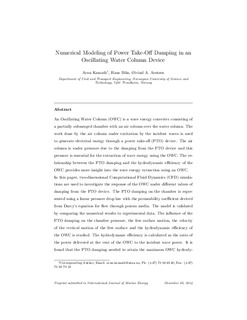| dc.contributor.author | Kamath, Arun | |
| dc.contributor.author | Bihs, Hans | |
| dc.contributor.author | Arntsen, Øivind Asgeir | |
| dc.date.accessioned | 2016-09-22T13:15:29Z | |
| dc.date.accessioned | 2016-09-29T14:41:10Z | |
| dc.date.available | 2016-09-22T13:15:29Z | |
| dc.date.available | 2016-09-29T14:41:10Z | |
| dc.date.issued | 2015 | |
| dc.identifier.citation | International Journal of Marine Energy 2015, 10:1-15 | nb_NO |
| dc.identifier.issn | 2214-1669 | |
| dc.identifier.uri | http://hdl.handle.net/11250/2412068 | |
| dc.description.abstract | An Oscillating Water Column (OWC) is a wave energy converter consisting of a partially submerged chamber with an air column over the water column. The work done by the air column under excitation by the incident waves is used to generate electrical energy through a power take-off (PTO) device. The air column is under pressure due to the damping from the PTO device and this pressure is essential for the extraction of wave energy using the OWC. The relationship between the PTO damping and the hydrodynamic efficiency of the OWC provides more insight into the wave energy extraction using an OWC.
In this paper, two-dimensional Computational Fluid Dynamics (CFD) simulations are used to investigate the response of the OWC under different values of damping from the PTO device. The PTO damping on the chamber is represented using a linear pressure drop law with the permeability coefficient derived from Darcy’s equation for flow through porous media. The model is validated by comparing the numerical results to experimental data. The influence of the PTO damping on the chamber pressure, the free surface motion, the velocity of the vertical motion of the free surface and the hydrodynamic efficiency of the OWC is studied. The hydrodynamic efficiency is calculated as the ratio of the power delivered at the vent of the OWC to the incident wave power. It is found that the PTO damping needed to attain the maximum OWC hydrodynamic efficiency increases with increasing incident wavelength. The formation of stagnation zones in the water due to high velocities for lower values of PTO damping is found to reduce the hydrodynamic efficiency. | nb_NO |
| dc.language.iso | eng | nb_NO |
| dc.publisher | Elsevier | nb_NO |
| dc.title | Numerical Modeling of Power Take-Off Damping in an Oscillating Water Column Device | nb_NO |
| dc.type | Journal article | nb_NO |
| dc.type | Peer reviewed | nb_NO |
| dc.date.updated | 2016-09-22T13:15:29Z | |
| dc.source.volume | 10 | nb_NO |
| dc.source.journal | International Journal of Marine Energy | nb_NO |
| dc.identifier.doi | 10.1016/j.ijome.2015.01.001 | |
| dc.identifier.cristin | 1194872 | |
| dc.description.localcode | 2015 Elsevier Ltd. All rights reserved. This is the authors' accepted and refereed manuscript to the article. Locked until 2017-07-01. | nb_NO |
